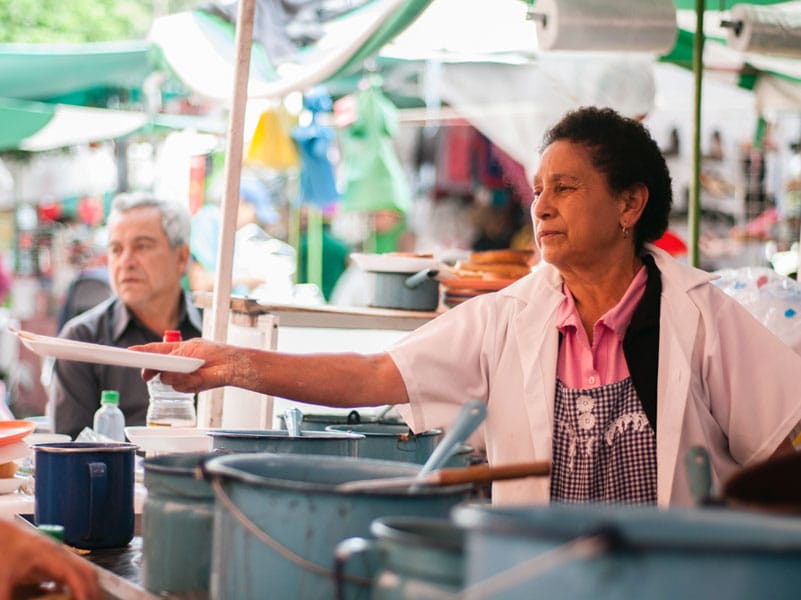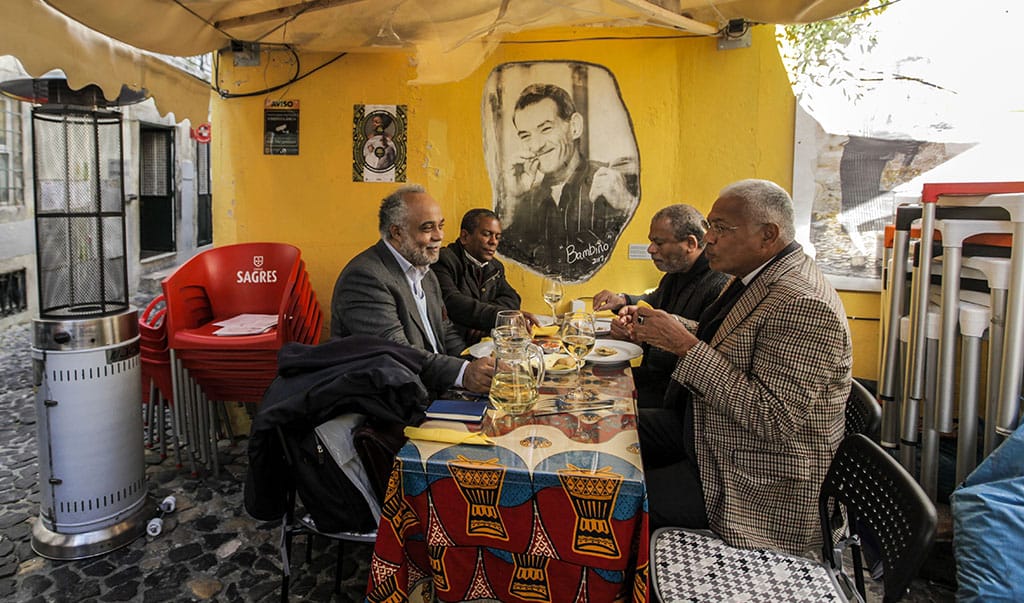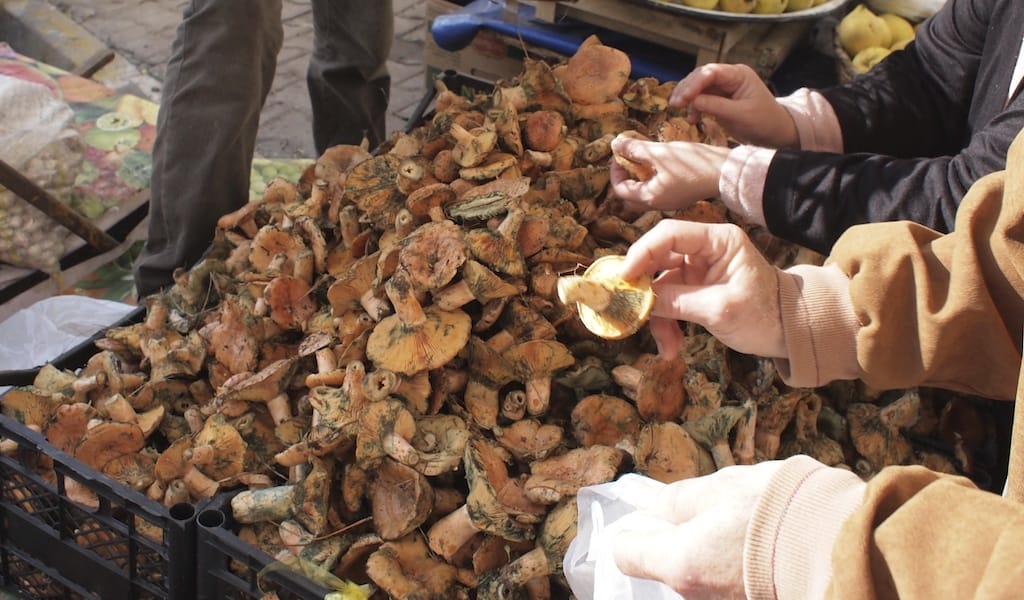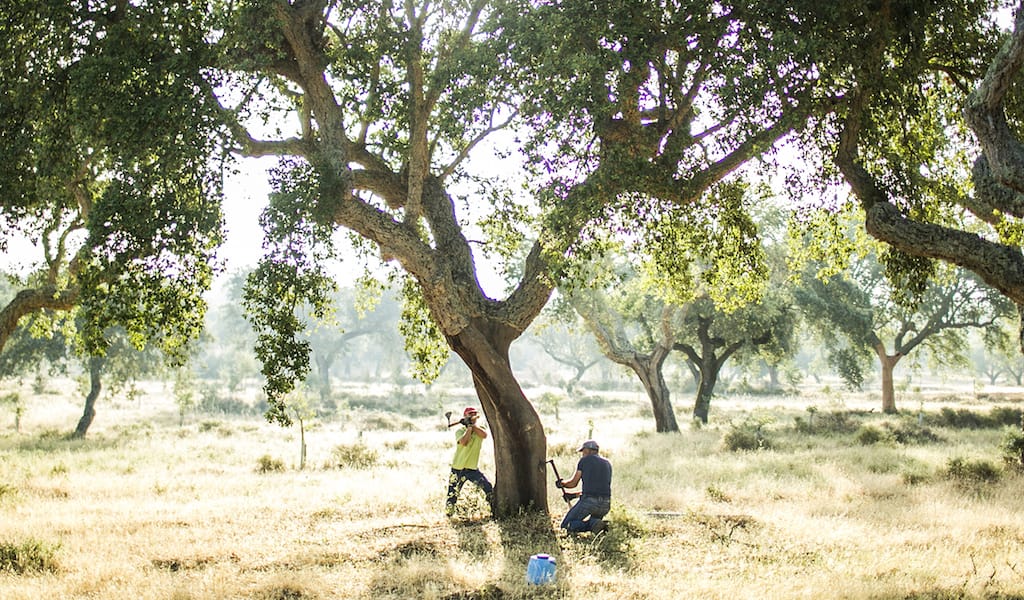The tianguis, or street market, has been an essential part of Mexican culture since pre-Hispanic times. In Mexico City, every neighborhood has at least one weekly tianguis, most selling produce, fish, meat and household goods, so families can buy all they need for the week in a single place. All of these markets, large or small, have one thing in common: an abundance of street food stands. Many of these vendors move around the city with the markets, and some have become so well-loved that neighborhood residents eagerly await the day of their local tianguis so they can enjoy tasty food served streetside.
One especially popular vendor is Señora Ema’s stand in the Guadalupe Tepeyac tianguis, which has drawn crowds of hungry market-goers for breakfast and early lunch every Tuesday for the last 47 years. Now around 70, Señora Ema started the business herself and continues to run it with the help of her family, including her daughter Veronica, her nephew Juanito, her niece Lumi and several other family members. Though there isn’t a set time when breakfast starts being served – the day we visited, the driver had slept in and the whole operation had been delayed – that doesn’t deter loyal customers from holding out for the promised feast.
A formidable woman despite her age, Señora Ema takes the lead in the food preparation, in addition to keeping track of who arrives first and overseeing the taking of orders. Veronica and the rest of the staff – who seem to regard Señora Ema with a deep respect that verges on fear – know better than to interfere in her system. “Just wait and ask her when she’s free,” Veronica told us when we attempted to place an order. In the background we heard Señora 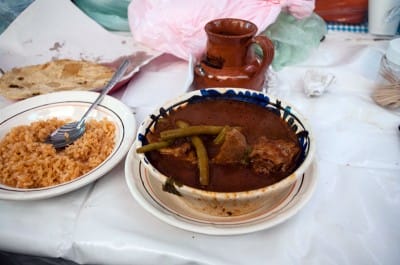 Ema’s commanding voice telling us to wait our turn, and we had no option but to obey. While waiting for our order to be taken, we asked Veronica – who’s in charge of drinks – for a café de olla, a traditional Mexican coffee made by boiling ground coffee beans in a large clay pot with piloncillo (similar to molasses) and cinnamon. We also had half a bolillo, a kind of bread roll, which was toasted below the flame on which Señora Ema makes the food and served with butter and sugar. When it eventually arrived, the egg and chili taco we had ordered – prepared with a handmade tortilla made by Señora Ema herself – was certainly worth the wait. The combination of egg and serrano chilies had just the right amount of spice to be enjoyed without being overpowering.
Ema’s commanding voice telling us to wait our turn, and we had no option but to obey. While waiting for our order to be taken, we asked Veronica – who’s in charge of drinks – for a café de olla, a traditional Mexican coffee made by boiling ground coffee beans in a large clay pot with piloncillo (similar to molasses) and cinnamon. We also had half a bolillo, a kind of bread roll, which was toasted below the flame on which Señora Ema makes the food and served with butter and sugar. When it eventually arrived, the egg and chili taco we had ordered – prepared with a handmade tortilla made by Señora Ema herself – was certainly worth the wait. The combination of egg and serrano chilies had just the right amount of spice to be enjoyed without being overpowering.
At around 10:30 a.m., Señora Ema’s stand (which also sets up on Sundays at a tianguis in Colonia Residencial Zacatenco) begins offering almuerzo, the Mexican version of brunch. This meal consists of soup – usually made with pasta (such as fideo, a short angel hair pasta) and a tomato sauce base – or rice and a main dish. Señora Ema’s main dishes vary from week to week. The day of our visit, the choices were pork in pipián, a kind of mole made with pumpkin seeds; chicken in tomato sauce; and mole de olla, a stew made with chunks of beef and vegetables (including corn, green beans and chayote, or pear squash) cooked in a salsa that incorporated a slew of mild chilies and spices. Since it was a cool and gloomy morning, we ordered the mole de olla and a plate of rice to warm our bodies.
At times the whole operation looks like it’s teetering on the edge of disaster, with cooks yelling, Señora Ema doing ten different things at a time, ingredients running out and customers reminding staff that they haven’t gotten their orders. But this seeming lack of order is what makes Señora Ema’s place special. The relatives who make up the staff tend to address each other in very 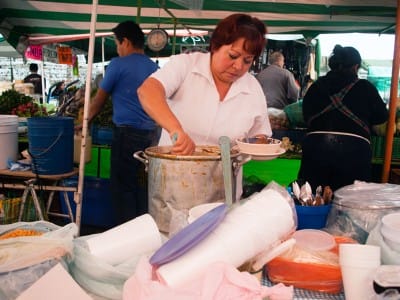 loud voices, but often what seems like yelling is just a boisterous jab or a friendly reminder to get things back on track. Meanwhile, customers seem to enjoy mingling with one another and being part of the lively atmosphere. “It’s just like dining with family!” one customer remarked to us as she patiently waited for her order.
loud voices, but often what seems like yelling is just a boisterous jab or a friendly reminder to get things back on track. Meanwhile, customers seem to enjoy mingling with one another and being part of the lively atmosphere. “It’s just like dining with family!” one customer remarked to us as she patiently waited for her order.
Despite the apparent chaos, Señora Ema clearly knows what she’s doing, having long ago figured out her own recipe for success: serving the same homemade recipes passed down from previous generations of strong and efficient cocineras, or female cooks. “I started helping my mom in the kitchen even before I could reach the stove,” Señora Ema told us. “I would stand on a chair to help her stir the salsas and stews.” With that kind of long legacy to uphold, it’s no wonder Señora Ema’s marketplace stand draws the kind of crowds it does.
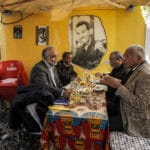 March 26, 2023 Post-Colonial Lisbon
March 26, 2023 Post-Colonial Lisbon
Lisbon’s communities from Portugal’s former colonies provide the strongest link to the […] Posted in Lisbon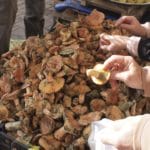 November 3, 2021 Hail Caesar’s
November 3, 2021 Hail Caesar’s
Editor's note: We're celebrating Mushroom Week at Culinary Backstreets, and today's […] Posted in Istanbul August 2, 2021 Bottle Stopper
August 2, 2021 Bottle Stopper
We were crawling through traffic on Porto’s ring road in our rental car when dawn […] Posted in Porto
Published on July 16, 2013
Related stories
March 26, 2023
LisbonLisbon’s communities from Portugal’s former colonies provide the strongest link to the country’s past, when it was the hub of a trading empire that connected Macau in the east to Rio de Janeiro in the west. Though integral elements of Lisbon life, these communities can sometimes be an invisible presence in their adopted land, pushed…
November 3, 2021
IstanbulEditor's note: We're celebrating Mushroom Week at Culinary Backstreets, and today's installment takes us to Istanbul's Belgrade Forest, where Turkey's leading wild mushroom expert has found some remarkable fungus specimens. “This would be front-page news in France!” Jilber raved, darting off between tall chestnut trees and oaks, obscured by a hazy steam that seemed to…
August 2, 2021
PortoWe were crawling through traffic on Porto’s ring road in our rental car when dawn finally caught up to us, illuminating the spectacular view of the Douro River down below. That slice of the waterfront quickly glided past as we exited the bridge, soon replaced by the lush rolling countryside south of the city: olive…







































